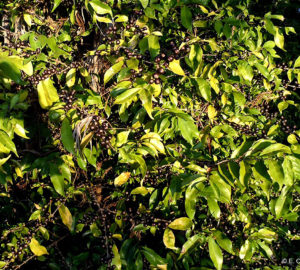Here’s a mind-bending exercise for you: Describe coffee.
No, you don’t get to ask further questions. You are not permitted a follow-up, such as, “Do you mean the plant or the drink?” or, “Like a Frappuccino?”
Sitting down and writing out a definition of coffee is much like one of those exercises of “describe milk” and “describe meat.” It is surprisingly difficult, and in both of those industries, the very nature of naming a product has been expensively battled out in the US courts (with legal proceedings that continue today).
I have never considered myself a coffee purist; I will die by my love of espresso tonics and espresso-based non-alcoholic drinks. But then I was presented with a drink that looked like coffee, tasted like coffee, but contained no ingredients derived from the coffee shrub. This experience confronted me with an unexpected question: “Is this still even coffee?”
As a plant, coffee is in the Coffea genus, from the family Rubiaceae. But as a beverage? Here’s where it gets tricky.
There are a lot of steps that happen between picking coffee cherries and serving a coffee beverage. In recent years, the topic of infusions and additives in coffee has been hotly discussed in the coffee world. There are no industry-agreed-upon definitions for these terms. “Additives” and “infusions” might mean the inclusion of whole fruit during coffee processing, or it might mean adding fruit flavor to a roasted coffee prompting questions about standards, labeling, and transparency. The former could be seen as experimental processing while the latter is perceived for the commodities market. The lack of a firm definition here has opened the door to varying interpretations and created the need for transparency and updated nomenclature. It’s as though the world of coffee production—and the interest of the consumer—are moving faster than our language can keep up with.
Now imagine if the very definition of “coffee” the beverage, went up for reconsideration.
“We believe coffee should, of course, taste like coffee and have the same molecular structure,” says Ed Hoehn, COO at Atomo Coffee. “This can be accomplished with coffee cherries and without.” Atomo offers a beanless coffee drink made of a blend of upcycled date seeds, grape, chicory, tea-derived caffeine, and more to match the molecular structure of coffee. We’ve been skeptical of Atomo over the years, but they’re a useful data point in thinking about how coffee is defined. If it looks like coffee and tastes like coffee… can it ever really be the drink we love?
Similar is the work of Imunika, a South Korean “boutique fermenter” that fuses coffee with mushrooms. “[Coffee] is never just about the drink, but the entire experience,” says Jinhu Park, the company’s founder and CEO. “Most mushroom coffees in the market simply blend dried mushroom extracts with ground coffee, providing a certain health benefit at the cost of flavor,” he explains. If you look at the nutritional label on other mushroom coffee bags, you’ll see adaptogenic mushrooms listed with coffee. Park’s company takes green coffee from Papua New Guinea, ferments it in South Korea for four weeks with beta-glucan, a mushroom essence derived from seven mushrooms, and then roasts it in Seattle. The final product is roasted whole bean coffee with the claimed nutritional benefits of the mushrooms.
In the coffee production timeline, Imunika’s coffee is fermented at the same time as a wine barrel-aged coffee would be, though you could argue that the aged coffee’s flavor reflects its process a lot more than the other.
***
Here’s a trickier question, perhaps: “Who gets to define coffee?” In my previously published article on the SCA’s new coffee value assessment, the global industry organization posits forth a definition for specialty coffee that could include infused coffees. Experimental processing methods—which may affect flavor and quality—may be seen as an extrinsic attribute that increases the coffee’s value, depending on who is evaluating it.
If we look to the US milk industry for guidance, the who for the industry is the U.S. Food and Drug Administration (FDA). However, the FDA is not an all-ruling dictatorship; it takes into account consumer feedback and corporate lobby efforts. Indeed, the definition of “milk” is being redrafted and opened up for public comment. The European Union already ruled in 2017 that plant-based milks could not use the word “milk.” All this aside, neither the FDA nor the EU cover the coffee industry in its global entirety.
So, does the power actually rest with consumers? You might pass a hundred laws and statutes to the contrary, but people are still going to call it “oat milk.”
Nico L Herr is the COO of Mountain Harvest, a Uganda-led and managed producer and exporter that works with around 1,500 smallholder farmers across that nation. At Mountain Harvest, they’ve experimented at the raw production level with “natural additives and inoculations such as yeasts, acids, or introduction of new sugars from fruits,” Herr tells me. One such example is the use of Lactobacillus culture from yogurt processing in fermentation. Herr describes the lactic natural process: “We dissolved this into a water solution, placed cherries and solution into barrels ensuring cherries are fully submerged, sealed the barrel, and fermented for 48 hours in a cool place.”
Experimenting with yeasts or other additives at the raw processing level is still a free-for-all territory in the industry, which makes it both exciting and unprecedented. It goes back to the original question: is this still “coffee” as we might commonly define it? Herr thinks that consumer belief is the most important thing. “It seems to have little to do with proportion of such an ingredient and more to do with the perception of the end consumer,” they tell me. “Really, the market decides.” Moreover, Herr sees these experiments as a possibility for Uganda to create its own origin narrative, and to make a name for themselves as creators of exciting, innovative, genre-bending coffees that consumers gravitate towards. “It would be a shame for an opportunity towards innovation to be squelched due to an overarching opinion of them being frowned upon.”

World Coffee Research recently released a whitepaper declaring coffee to be in an innovation crisis. The current investment in agricultural research and development is “shockingly low” for the value that coffee holds in the market. The researchers warn, “Assuming continued high demand growth and negative impacts of climate change on yield and land area, even today’s highly productive regions will not be able to meet 100% of global demand growth in 10 years.”
If the industry as a whole does decide to move forward with a definition of coffee, it’ll be interesting to see how discussion shows up and where/when government bodies appear. On one hand, we run the risk of stifling innovation. Is this a risk that we’re willing to take when the industry is already precariously perched? On the other hand, specialty coffee could be seen as a “brand” and any marketer would tell you that a brand’s value risks dilution if you don’t draw lines in the proverbial sand.
“Coffee comes from a plant of the genus Coffea,” says George Howell, CEO and founder of George Howell Coffee. “Anything else is artificial and should be labeled as such.” Full stop. Howell has spent almost five decades in the coffee industry and observed many trends come and go. To him, the current practice of additives and infusions is “the 21st-century version of flavored coffee—which was so popular in the 1980s. A fine coffee is diminished by any means used to alter its flavor for the sake of novelty or false pretenses.” If the inclusion of additives and infusions continue on in specialty coffee, he believes that “it will further nail it to being a commodity, from the farmer’s point of view.”
These thought exercises are important if we want to be clear in our definitions. Does a coffee drink need to have the plant in it? If coffee is grown next to aromatic plants and takes on those as flavor notes, is it infused coffee? Are experimental processes innovating in a way that will help sustain the industry’s future?
We have a lot to consider in defining coffee. And even if consumers hold the power, the industry can still set some standards, such as clear labeling practices. But we also should not forget that experimentation is a privilege and expensive to perform. “Coffee farmers, for the most part, still do not drink their coffee,” Howell tells me. He adds, “How do we get the world to drink black coffee? To me, that is the next necessary step. In the meanwhile the noise gets louder.”
Jenn Chen (@thejennchen) is an Editor At Large at Sprudge Media Network. Read more Jenn Chen on Sprudge.
































